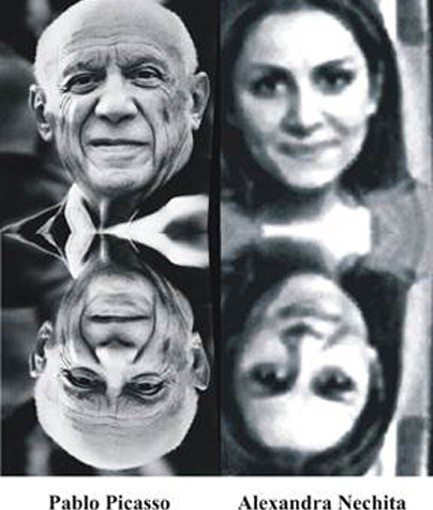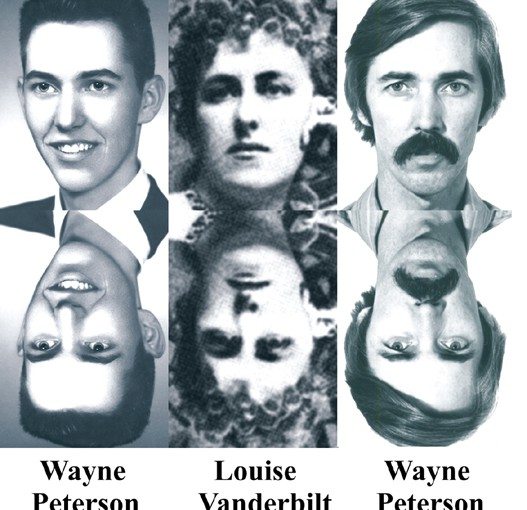How Case Derived: Past Life Memories in Childhood and Spirit Being Guidance
Researcher: Wayne Peterson
Article by Walter Semkiw, MD from Born Again
Little Wayne remembers a Past Lifetime with Women in Billowing Gowns and a Man named Fred: A Past Life Vision of the Vanderbilt Mansion
 Wayne Peterson has experienced memories of a past lifetime in which he was Louise Vanderbilt, wife of Frederick Vanderbilt, a member of the American Vanderbilt dynasty. Through marriage, Louise was a relative of Gloria Vanderbilt, who is the mother of CNN’s Anderson Cooper. Click on facial comparison images to enlarge them.
Wayne Peterson has experienced memories of a past lifetime in which he was Louise Vanderbilt, wife of Frederick Vanderbilt, a member of the American Vanderbilt dynasty. Through marriage, Louise was a relative of Gloria Vanderbilt, who is the mother of CNN’s Anderson Cooper. Click on facial comparison images to enlarge them.
In contrast to the childhood remembrances regarding his Francesco Foscari past lifetime, Wayne’s memories of the Vanderbilt lifetime were more direct and visual. Wayne narrates the turn of events:
“My earliest memories in childhood included detailed images of a time when women wore long billowing gowns and people still used horse drawn carriages. I remembered specifically a large sandstone house, a man named Fred, friends arriving for social gatherings, a large reception area with a high ceiling and floors of white stone.
Central to all this I remembered most a woman that was the center of all related activity. The mystery lady was the center of several scenes that were repeated again and again during my earliest years and continued even to this day. I used to wonder who these people were and wondered why they appeared so real to me.
 As a young child I believed these people were part of my current life. Why they never visited our home I could never explain. I actually believed they would arrive one day and they would remember me and unexplainably, I would be very happy. I assumed that in my earlier years as an infant I had perhaps experienced these people with my parents and had now forgotten most of those intimate experiences. It was the only way I had as a child to explain the vividness of these people I visited in my dreams. However, these people never did appear in this current life and I remained at a loss to explain their appearance in my mind. I had no knowledge of reincarnation at that early preschool stage of my life.”
As a young child I believed these people were part of my current life. Why they never visited our home I could never explain. I actually believed they would arrive one day and they would remember me and unexplainably, I would be very happy. I assumed that in my earlier years as an infant I had perhaps experienced these people with my parents and had now forgotten most of those intimate experiences. It was the only way I had as a child to explain the vividness of these people I visited in my dreams. However, these people never did appear in this current life and I remained at a loss to explain their appearance in my mind. I had no knowledge of reincarnation at that early preschool stage of my life.”
Wayne, who was born in 1942, reflects that these memories were especially odd since in the 1940’s, there was no television, nor did he any see motion pictures, that might have fueled his imagination. He reflects that nothing in his real time experience of a small town in central Wisconsin correlated to his visions. Clothing, houses and social manners were entirely different in Wisconsin than what he experienced in his memories.
Yet a man named Fred, women in billowing gowns transported in horse drawn carriages and the large sandstone house, were very real to little Wayne. Perplexed, Wayne asked his mother about these people and the house that he remembered. He asked if he had been ever taken to such a place as an infant. The answer was always no. Though he could not explain the source of his memories, these memories continued to be a source of comfort, and he maintained a nostalgic emotion for a person named Fred.
A Flashback of a Past Lifetime on Fifth Avenue in New York City in Front of the Old Vanderbilt House
 As a young adult, Wayne Peterson joined the Peace Corps and was on route to Brazil. His flight to Rio de Janeiro was via New York City. Since Wayne had never been to this big city before, he arranged to have a few days in NYC, to take in the sights of the Big Apple. On his second day in NYC, at about noon, Wayne was walking down Fifth Avenue. He was impressed by the crush of people. Let us now allow Wayne to narrate the scene, as he stood on the sidewalk of Fifth Avenue:
As a young adult, Wayne Peterson joined the Peace Corps and was on route to Brazil. His flight to Rio de Janeiro was via New York City. Since Wayne had never been to this big city before, he arranged to have a few days in NYC, to take in the sights of the Big Apple. On his second day in NYC, at about noon, Wayne was walking down Fifth Avenue. He was impressed by the crush of people. Let us now allow Wayne to narrate the scene, as he stood on the sidewalk of Fifth Avenue:
“Suddenly a woman with a hat and white gloves across the wide sidewalk waved her hands in my direction and shouted, ‘Louise, Louise, over here, it’s me.’ She kept shouting Louise and I froze. I instantly believed she was calling me. For whatever reason, I suddenly believed I was Louise.
All my attention focused on this strange woman moving in my direction through the crowd. In my mind I was someone else, someone named Louise. I believed the woman moving toward me was an old friend, but the face did not look familiar.
Nevertheless, there was a great relief within my mind, I thought that finally someone recognized the real me. Not the young man from Wisconsin, but a woman named Louise. It was as if I had been a victim of amnesia and suddenly someone shocked me into reality. Unfortunately, the moment of intense excitement passed when the woman in the hat and gloves brushed past me and grabbed an elderly woman standing directly behind me.
 Instantly, my mind was on overload and I could not move or think. I was still having a moment as Louise and I looked at these two women and thought, you fools, why don’t you remember me? I am the real Louis. How long I stood and stared at these two women enjoying their renewed acquaintance I do not know, but eventually my logical mind returned and I was forced to question my actions and thinking.
Instantly, my mind was on overload and I could not move or think. I was still having a moment as Louise and I looked at these two women and thought, you fools, why don’t you remember me? I am the real Louis. How long I stood and stared at these two women enjoying their renewed acquaintance I do not know, but eventually my logical mind returned and I was forced to question my actions and thinking.
Embarrassed and bewildered, I returned to my hotel room. In the hotel I relaxed on the bed and for some hours pondered what had just happened. Why, I kept wondering, did I think I was Louise? Why was it so real to me and so important that I be Louise? I pondered this strange experience during my entire stay in New York, but found no answer until years later. Nonetheless, I was content that I was Louise in a past life about the turn of the century and that Fred was my husband.”
Wayne feels Past Life Frustration due to Fred’s Shyness
“What I knew of Louise and Fred was not only a few visions from this presumed past life, but I could feel emotions that were from Louise. I intuitively knew she was often frustrated with Frederick at social events. Louise would be in the huge reception area of the house greeting guests. She wore several dresses that I could remember in great detail. I always envisioned Fred in white tie and jacket with tails. He appeared to be perfectly comfortable dressed in that attire. but whenever possible he escaped to the small office/library. I can vividly remember the library door. Inside the library it would be quiet and Fred would be seated in the high backed sofa that hid him from the view of anyone at the doorway exit. Eventually, Louise grew tired of making excuses to the guests about Fred’s absence.”
Wayne Unexpectedly refers to his Vanderbilt Past Life Relatives
 In these past life reminiscences experienced when he was a very young man, Wayne Peterson still did not know who Fred and Louise were specifically. Decades later, in the 1990’s, a hint came when Wayne was visiting an upper class friend in New York City, whose name was Mary. This upper class friend insisted that Wayne join her on a vacation at her Irish house on the South coast of Ireland. Mary said that they would have a wonderful time and added that her friend Gloria would be joining them also.
In these past life reminiscences experienced when he was a very young man, Wayne Peterson still did not know who Fred and Louise were specifically. Decades later, in the 1990’s, a hint came when Wayne was visiting an upper class friend in New York City, whose name was Mary. This upper class friend insisted that Wayne join her on a vacation at her Irish house on the South coast of Ireland. Mary said that they would have a wonderful time and added that her friend Gloria would be joining them also.
Wayne asked, “Gloria who?” Mary replied, “It’s my friend Gloria Vanderbilt.” Let us allow Wayne describe his reaction to this statement regarding Gloria Vanderbilt, whose photo is provided to the right:
“Instantly my logical mind was again paralyzed just as it had been years before when in New York City that elderly woman shouted the name Louise. Another personality or another identity took over my consciousness and I said, ‘Great, Gloria and I can chat and gossip about our family relatives.’
There was a silence from my friend Mary and I began to realize what I had just said. Mary asked what I meant by common family relatives and I babbled nervously about something while trying to think up any good excuse for my ridiculous statement.
Eventually, I explained that I thought Gloria had an interesting family tree. After terminating that conversation I realized that for a few moments I was transported into another life. It was so total that I really believed I was a relative of Gloria Vanderbilt and we could indeed gossip about family members. Why, I kept wondering again, why did I say such a stupid thing with such conviction?”
Spirit Being, Spiritual or Soul Guidance: A Book Magically Moves and Attaches Itself to Wayne’s Hand-A Case of Psychokinesis
“In the days that followed my conversation with Mary I began to wonder if there ever could have been a Frederick and Louise Vanderbilt. No, I reasoned the odds against it were simply too remote to even bother to explore. Nevertheless, some weeks later while wandering in my favorite bookstore, my attention was attracted to a book on the wealthy families of the 1800’s and early 1900’s. I noticed the book only because it was on the lowest shelf and protruding into the aisle by some 4 to 5 inches.
 Although I pushed the book into its proper alignment several times with my foot, the book continued to spring forward multiple times before I finally picked it up and read its cover. I even explored on my hands and knees what was in the shelf which forced the book out into the isle. There was nothing but an empty space behind the book.
Although I pushed the book into its proper alignment several times with my foot, the book continued to spring forward multiple times before I finally picked it up and read its cover. I even explored on my hands and knees what was in the shelf which forced the book out into the isle. There was nothing but an empty space behind the book.
Curious, I briefly looked at the price of the book, which was expensive, and I immediately wanted to place it back on the shelf. For whatever reasons, I could not give up the book although my mind wanted to place it back on the shelf. As I could not get my hand to release the book, I reasoned I had to buy it in order to leave the store. When I tried to give the book to the cashier so that he could make the sale, the cashier had to pull with both of his hands to dislodge the book from my grasp, despite my desire to let go of it. After paying for the book, I was angry with myself for having no self-control over purchasing a book I did not want. I took the book home and placed it on my own bookshelf thinking that this is one book that I will probably never read, and therefore it was a total waste of money.”
Wayne identifies his Past Life Home with Women in Billowing Skirts and a Man named Fred Vanderbilt
“However, later that night I had a dream that I must read this new book. Unable to sleep because of this nagging notion, I went downstairs and opened the book. At first nothing captured my imagination but soon I opened a page that totally took me by surprise.
There in full color was a photo of the very room I had always envisioned as a child. The distinctive ceiling, the fireplace and white marble floor and the very same sofas I so clearly remembered. It was all there as if only yesterday I had stepped out of that room.
 The next page was even more revealing. Again, in a color photo, was the library/office I knew so well. The pale green sofa that Fred would hide in during social events and the two beautiful desks that were part of a his and hers arrangement. Transfixed in wonderment, I thought about the strange attachment I had to this scene and what I might learn from this extraordinary experience.
The next page was even more revealing. Again, in a color photo, was the library/office I knew so well. The pale green sofa that Fred would hide in during social events and the two beautiful desks that were part of a his and hers arrangement. Transfixed in wonderment, I thought about the strange attachment I had to this scene and what I might learn from this extraordinary experience.
I began to read the article that went with the photos. The room was part of the Vanderbilt Mansion, which was built by Frederick Vanderbilt in Hyde Park, New York in the late 1800’s. Wouldn’t it be a strange coincidence, I thought, if this Fred Vanderbilt had a wife named Louise? As I read down the page, I was overwhelmed when I read that Frederick was married to Louise H. Anthony. The following pages were most revealing, especially when I saw the color photos that followed…The photos brought to life the rooms that I remembered from my earliest memories as a child. I realized that I had opened a book that revealed all the secrets of a past life.”
Spiritual or Soul Guidance: Reincarnation Geographic Memory on Fifth Avenue
Wayne also read that though their sandstone Hyde Park mansion (pictured near the top of this page) was their favorite, their main home was on Fifth Avenue, in New York City. Though this home in NYC was torn down, the location that Wayne had his “Louise” experience on Park Avenue as a young man indeed the location where the Vanderbilt home had been located on Fifth Avenue. The fact that Louise Vanderbilt lived on Fifth Avenue sheds further light on young Wayne’s experience on Fifth Avenue, when the elderly woman in white gloves called out “Louise,” and Wayne was transported to his past incarnation as Louise.
I term this phenomenon of a geographic setting triggering past life experiences as Geographic Memory, which is also observed in the: Reincarnation Case of John B. Gordon | Jeff Keene
Wayne Peterson & Louise Vanderbilt have a Common Interest in Metaphysics
Wayne also learned that Louise and Frederick were very interested in metaphysics, including Theosophy, as is Wayne in contemporary times. In his current incarnation, Wayne is a scholar of the work of Alice Bailey. Louise was also a great fan of the grand ladies of 18th century France, especially Marie Antoinette. Louise Vanderbilt had even filled her bedroom with French reproduction furniture.
This has significance in relation to another past lifetime that has been identified for Wayne, that of Claude Ledoux, who was an artist and architect associated in the Court of Louis XVI and Marie Antoinette. The Claude Ledoux | Wayne Peterson reincarnation case is featured in Born Again. Louise died in 1926, in Paris, which was one of her favorite cities. Frederick lived out his remaining years largely in seclusion, passing away in 1938.
Reincarnated Fredrick Vanderbilt in Contemporary Times
 Frederick, by the way, has also been identified in contemporary times. Fred turns out to be a friend who Wayne Peterson has known for years, who shares with Wayne an interest in metaphysics. Though Wayne had known this person for a period of time, his identity as Frederick Vanderbilt was not determined until the year 2004. At that time, Frederick and Louise Vanderbilt were consciously reunited, 78 years after they were separated by death.
Frederick, by the way, has also been identified in contemporary times. Fred turns out to be a friend who Wayne Peterson has known for years, who shares with Wayne an interest in metaphysics. Though Wayne had known this person for a period of time, his identity as Frederick Vanderbilt was not determined until the year 2004. At that time, Frederick and Louise Vanderbilt were consciously reunited, 78 years after they were separated by death.
Summary & Reincarnation Case Analysis
Key elements of this case include Wayne’s vivid memories in childhood of a lifetime in which women wore nineteenth century clothing and where parties were held in a large sandstone, mansion-like house. Later, in adulthood, Wayne had memories of being a woman name Louise, which were triggered by standing at the very spot where Louise and Fredrick Vanderbilt lived on Fifth Avenue in NYC. Though this event initially seems coincidental, it is likely that this event was orchestrated by spirit beings, or perhaps Wayne’s own soul.
Guidance to a past life geographic location, which triggered discovery of a past lifetime, also occurred in the case of Reincarnation Case of John B. Gordon | Jeff Keene.
Guidance by spirit beings was even more evident in the scene at the bookstore, where a book was magically pushed out of a bookshelf repeatedly. When Wayne grasped this book, he was unable to release it, which led to him purchasing this book on nineteenth century homes against his conscious will. In this book, Wayne found the house and rooms that he so vividly saw in his memories as a child. The home was owned by Fred and Louise Vanderbilt, which allowed Wayne to solve the past life puzzle that he had struggled with since childhood.
Of note, this case, if accepted, demonstrates that gender can change from one incarnation to another, though facial features, bone structure of the face, remains consistent.
If this reincarnation case demonstrates the following features:
Physical Resemblance in Reincarnation Cases: Wayne’s facial features are consistent with those of Louise Vanderbilt, despite the change in gender.
Reincarnation & Change of Gender: Louise was a woman, who reincarnated as Wayne, a male.
Reincarnation & Geographic Memory: Wayne had a past life flashback at the spot on Fifth Avenue where Fred and Louise Vanderbilt had a home.
Spirit Being & Soul Guidance in Reincarnation Cases: The architectural book that featured the Vanderbilt Hyde Park home, which allowed Wayne to solve this reincarnation case, magically moved from a bookshelf and then attached itself to Wayne’s hand, which forced Wayne to purchase it. This represents psychokinesis, where an physical object is moved by psychic means, in this case apparently by a spirit guide. Psychokinesis is prominent in the reincarnation case of Daniel D. Home | Uri Geller, which is featured in Born Again. A dream then prompted Wayne to read the book in the middle of the night.
In addition, the incident on Fifth Avenue where Wayne had a past life flashback was likely orchestrated by a spirit being, or perhaps by Wayne’s own soul.
Reincarnation, Innate Talent & Past Life Behavior: Louise Vanderbilt studied astrology and Theosophical literature. Wayne has continued this interest by becoming a scholar of the Alice Bailey material. In addition, Wayne is a published author on spirit beings with his book, Extraordinary Times, Extraordinary Beings.
Renewal of Relationships through Reincarnation: Louise and Frederick Vanderbilt appear to have been reunited through reincarnation. In contemporary times, they are both heterosexual men, who are friends without any romantic involvement.
 How Derived: Past Life Memories in Childhood
How Derived: Past Life Memories in Childhood Daw had a younger female friend whose name was Khin San Tint, who we will refer to as Tint. Though Tint was not a relative, there was a close connection between her and Daw. In fact, Daw kept a photograph of Tint at her home and conversely, Tint kept a photo of Daw at her home.
Daw had a younger female friend whose name was Khin San Tint, who we will refer to as Tint. Though Tint was not a relative, there was a close connection between her and Daw. In fact, Daw kept a photograph of Tint at her home and conversely, Tint kept a photo of Daw at her home. When Tun started to speak at 18 months of age, he made more direct references to his previous life as Daw Soe. For example, Tun talked about the relatives of Daw Soe who lived in Nga-Zun, Burma, though Tun had never been there.
When Tun started to speak at 18 months of age, he made more direct references to his previous life as Daw Soe. For example, Tun talked about the relatives of Daw Soe who lived in Nga-Zun, Burma, though Tun had never been there. Split Incarnation
Split Incarnation Suicide and Reincarnation Case of Helmut Kohler | Ruprecht Schultz
Suicide and Reincarnation Case of Helmut Kohler | Ruprecht Schultz











































 How Derived:
How Derived:  Reincarnation & Planning Lifetimes: Daw has an Announcing Dream involving the Japanese Soldier as a Spirit Being
Reincarnation & Planning Lifetimes: Daw has an Announcing Dream involving the Japanese Soldier as a Spirit Being A Child’s Past Life Memories: Ma says She misses Japan and her Family
A Child’s Past Life Memories: Ma says She misses Japan and her Family The US War Plane that Killed Ma in a Past Lifetime was a P-38 Lightning
The US War Plane that Killed Ma in a Past Lifetime was a P-38 Lightning Other reincarnation cases which demonstrate gender identity issues due to change of sex include:
Other reincarnation cases which demonstrate gender identity issues due to change of sex include:






